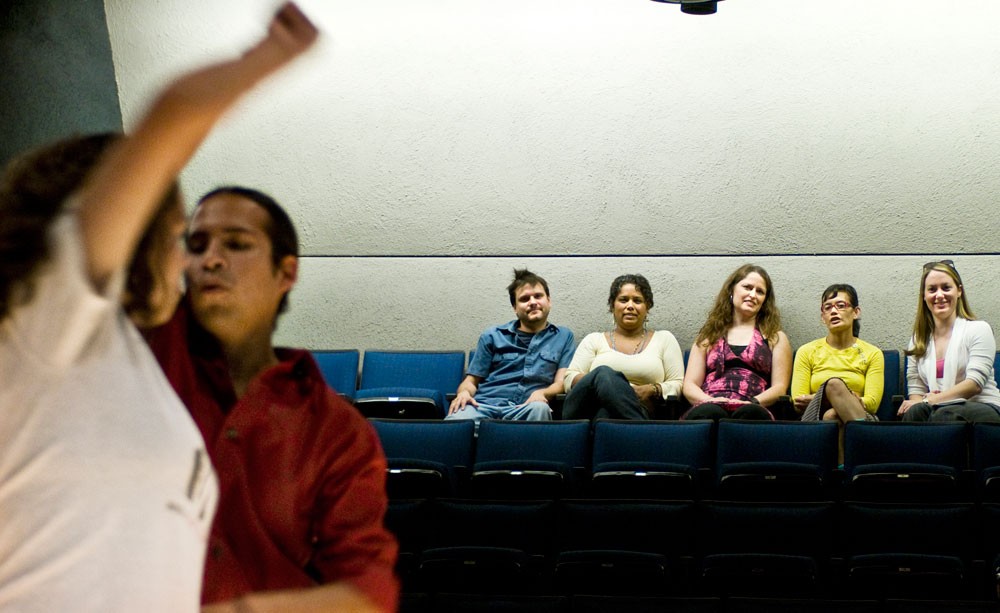Like the lead character in her play, Cindy Garcia has spent the past nine years researching social practices in salsa clubs. âÄúIn many ways, this is my life,âÄù Garcia said of her script, titled âÄúHow to Make it to the Dance Floor: A Salsa Guide for Women (Based on Actual Experiences).âÄù The script, which received a staged reading Monday to a packed Kilburn Arena Theater in Rarig Center, is the product of GarciaâÄôs ethnography of Los Angeles salsa clubs. Garcia, 39, is in her second year as an assistant professor in the UniversityâÄôs Department of Theatre Arts and Dance. In the play, a character dubbed âÄúThe Ethnographer,âÄù along with a small group of women, question why they are not being asked to dance. They begin an anonymous dialogue with one other by writing notes on the walls of bathroom stalls. Their writing describes noticed behavior and personal stories of feeling unaccepted in the club. Garcia said the women create a dialogue that deciphers the rules of hierarchies of race, class and gender, as well as the hierarchies of âÄúLatino-ness.âÄù These topics are exactly what Garcia set out to research as a graduate student at UCLA in culture and performance. As she started visiting Los Angeles salsa clubs, she found that many of the political and social issues outside the club dictated how people interacted inside the club. One of the hierarchies she observed was the way people danced. âÄúAt the top were practices that seemed to be more global âĦ practices that would almost un-racialize you,âÄù Garcia said. Garcia said these global dances worked to recast Latinos as âÄúGlobal Latinos.âÄù Dancers who bounce too much or cross back laterally instead of stepping forward and back were branded as dancing like an immigrant or a Mexican, which carries a negative connotation, according to GarciaâÄôs research. Women who are branded with these labels are often not asked to dance by the men in the club. Garcia said to be branded as an immigrant or a Mexican can have a drastic effect on an individual. While some people are proud of the way they dance, others internalize the judgment. âÄú[Dancers] learn not to dance the way that they were accused,âÄù Garcia said. âÄúThey learn to dance another style.âÄù Garcia, who grew up dancing with her fatherâÄôs family âÄî whose members are Chicano âÄî said her style of dance would be branded as âÄúMexicanâÄù in a salsa club. Garcia said the brandings come from the politics outside the club that are anti-Latino. âÄúThere comes this system of classification of âÄòWhere do you fit in the [United States]? How is it OK to be Latino?âÄô and itâÄôs not OK. ItâÄôs the bottom of the hierarchy,âÄù Garcia said. âÄúItâÄôs the working poor.âÄù âÄúThe play negotiates the tensions of a social space, the tensions between immigrant communities,âÄù Lucy Burns , who helped Garcia shape the script, said. Burns, who is an assistant professor in the UCLA Asian American Studies Department , has worked on the play since last summer, when Garcia started putting the script together. As Garcia looked to put a cast together for the reading, she wanted to find a group of Latinos and Latinas who had a connection to material as opposed to looking for individuals trained in acting. Through this search, Garcia found herself with a racially diverse cast featuring both University and non-University performers. Laura Garcia , a Minneapolis-based professional actor who plays The Ethnographer, was drawn to the project by her friendship with Garcia and an interest in the subject. Laura Garcia said she felt the reading featured great movement and music, and would be an eye-opener. âÄúSome people donâÄôt think about [this topic] because they donâÄôt have to think about it; others think about it all the time,âÄù Cindy Garcia said. âÄúItâÄôs important to know that it is something somebody else has to live with.âÄù Cindy Garcia said she was pleased with the reading and plans to rewrite the script in hopes of staging a full production in the future.
U prof takes scholarly approach to salsa dancing

Image by Paul Bangasser
Dancers rehearse before the staged reading of “Make it to the Dance Floor: A Salsa Guide for Women (Based on Actual Experiences),” while playwright Cindy Garcia and associates watch Monday in the Rarig Center. The writing describes noticed behavior and personal stories of feeling unaccepted in the club.
Published September 24, 2008
0

